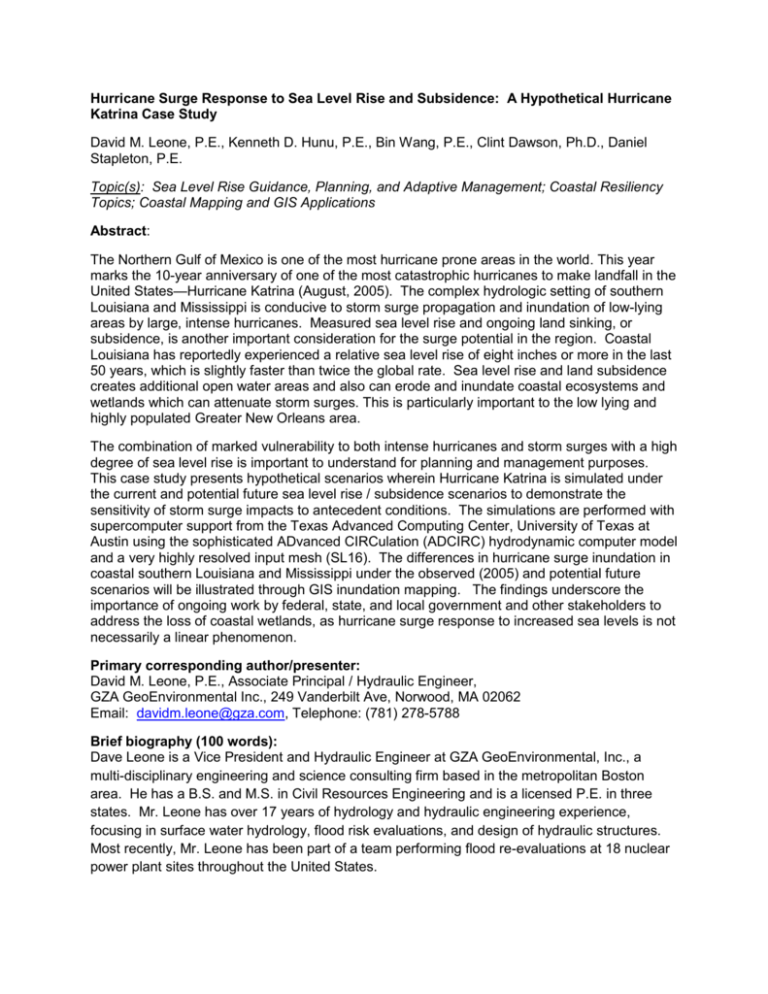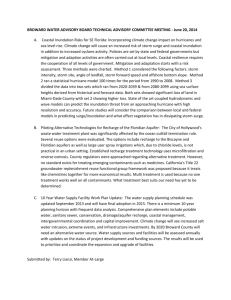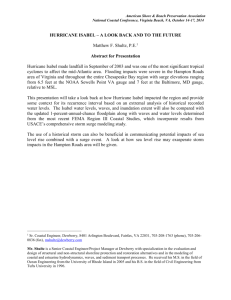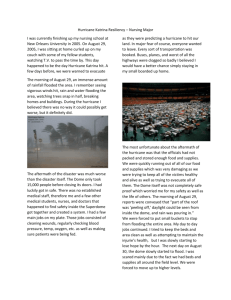Hurricane Surge Response to Sea Level Rise and
advertisement

Hurricane Surge Response to Sea Level Rise and Subsidence: A Hypothetical Hurricane Katrina Case Study David M. Leone, P.E., Kenneth D. Hunu, P.E., Bin Wang, P.E., Clint Dawson, Ph.D., Daniel Stapleton, P.E. Topic(s): Sea Level Rise Guidance, Planning, and Adaptive Management; Coastal Resiliency Topics; Coastal Mapping and GIS Applications Abstract: The Northern Gulf of Mexico is one of the most hurricane prone areas in the world. This year marks the 10-year anniversary of one of the most catastrophic hurricanes to make landfall in the United States—Hurricane Katrina (August, 2005). The complex hydrologic setting of southern Louisiana and Mississippi is conducive to storm surge propagation and inundation of low-lying areas by large, intense hurricanes. Measured sea level rise and ongoing land sinking, or subsidence, is another important consideration for the surge potential in the region. Coastal Louisiana has reportedly experienced a relative sea level rise of eight inches or more in the last 50 years, which is slightly faster than twice the global rate. Sea level rise and land subsidence creates additional open water areas and also can erode and inundate coastal ecosystems and wetlands which can attenuate storm surges. This is particularly important to the low lying and highly populated Greater New Orleans area. The combination of marked vulnerability to both intense hurricanes and storm surges with a high degree of sea level rise is important to understand for planning and management purposes. This case study presents hypothetical scenarios wherein Hurricane Katrina is simulated under the current and potential future sea level rise / subsidence scenarios to demonstrate the sensitivity of storm surge impacts to antecedent conditions. The simulations are performed with supercomputer support from the Texas Advanced Computing Center, University of Texas at Austin using the sophisticated ADvanced CIRCulation (ADCIRC) hydrodynamic computer model and a very highly resolved input mesh (SL16). The differences in hurricane surge inundation in coastal southern Louisiana and Mississippi under the observed (2005) and potential future scenarios will be illustrated through GIS inundation mapping. The findings underscore the importance of ongoing work by federal, state, and local government and other stakeholders to address the loss of coastal wetlands, as hurricane surge response to increased sea levels is not necessarily a linear phenomenon. Primary corresponding author/presenter: David M. Leone, P.E., Associate Principal / Hydraulic Engineer, GZA GeoEnvironmental Inc., 249 Vanderbilt Ave, Norwood, MA 02062 Email: davidm.leone@gza.com, Telephone: (781) 278-5788 Brief biography (100 words): Dave Leone is a Vice President and Hydraulic Engineer at GZA GeoEnvironmental, Inc., a multi-disciplinary engineering and science consulting firm based in the metropolitan Boston area. He has a B.S. and M.S. in Civil Resources Engineering and is a licensed P.E. in three states. Mr. Leone has over 17 years of hydrology and hydraulic engineering experience, focusing in surface water hydrology, flood risk evaluations, and design of hydraulic structures. Most recently, Mr. Leone has been part of a team performing flood re-evaluations at 18 nuclear power plant sites throughout the United States.








